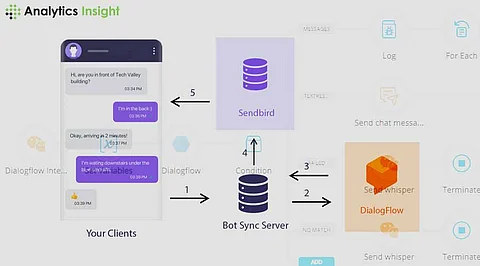

The growing demand for conversational agents has pushed businesses to increasingly leverage AI-powered chatbots. These chatbots are being used to automate customer communication while providing 24/7 service to positively impact the user experience. Among the widely used tools in the creation of such AI-driven chatbots is Dialogflow. It is a Google-based NLU tool that allows developers to easily and precisely design conversational interfaces.
Let’s explore the features, setup processes, and practical use cases of building AI chatbots with Dialogflow in the upcoming sections.
Dialogflow comes packed with features that make it a perfect choice for developing intelligent chatbots:
1. Natural Language Processing (NLP): Dialogflow can easily understand human language through Google's machine learning. It can be very flexible about the differences in structures and words to cover all types of questions a user might use to phrase their query.
2. Support for multiple languages: Companies worldwide can exploit this capability to create bots that support rich multi-language support.
3. Prebuilt Agents: The application provides a variety of pre-built agents that can be easily customized for a specific use case, helping developers who have very little or no coding experience.
4. Integration capabilities: The application provides very wide integration capabilities with multiple platforms including Google Assistant, Facebook Messenger, Slack, and several others.
5. Analytics and Insights: This allows for monitoring user interaction, discovering recurrent problems, and improving the chatbot's effectiveness over time.
1. Create a Dialogflow Agent: The first step is to create an agent from console.dialogflow.com. The agent acts as your project or bot on which you will be working. After its setup, it will process user input, providing the right responses.
2. Intents: The building blocks of functionality in Dialogflow are intents. Each intent manifests as a possible action or even query that a user might pose. For instance, in a customer service bot, intents could be "Order Status," "Product Information," or "Return Policy." In Dialogflow, it is the machine learning that matches an input from the user with its closest intent.
3. Entities: Entities enable the ability of Dialogflow to extract meaningful information from user input. For example, if a user seeks details of a flight, then terms such as dates, location, and airline names recognized by Dialogflow are treated as entities, which can then be processed to give a relevant response to the user.
4. Design Response: Upon an intent being matched, the bot needs to respond. Dialogflow supports text as well as voice-based responses. You can design static as well as dynamic responses by connecting backend systems, pulling data in real time, and delivering relevant answers to the user.
5. Testing the Bot: Dialogflow allows simulating within the platform, enabling testing of the functionality of the chatbot. The intents will get matched correctly, responses will be relevant, and the chatbot will act as it should before going live.
6. Integration with Other Platforms: After testing, your chatbot can be easily integrated into several platforms such as Google Assistant, Telegram, or a website. Out-of-the-box integrations by Dialogflow minimize the need to write further code.
1. Customer service: Organizations use Dialogflow to automate their operations in customer services. Customer bots can serve general services, and orders, consultancy services, and troubleshooting services.
2. Healthcare: Patients can book appointments, find some basic information, or be reminded of their upcoming appointments by using dialog flow bots.
3. E-commerce: Here, websites can use AI chatbots to aid the customer in the buying process, suggest products, and clarify issues post-purchase.
4. Education: Such chatbots are being increasingly used by educational institutions to provide course information, explain admissions-related questions, and even hold quizzes or tests on a student.
Dialogflow can be considered a strong flexible tool to develop AI-powered chatbots for business use. It has state-of-the-art NLP functionalities and ease of integration and scalability. Thus, it’s a great tool for businesses looking to improve through increased customer engagement and fast service delivery. Dialogflow is surely a blessing for people from non-tech backgrounds due to its low coding requirements. Thus, one can use this versatile application to make a career in the rapidly growing artificial intelligence field.
